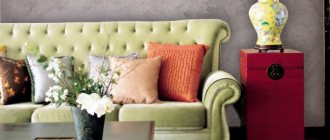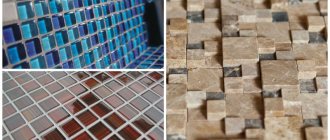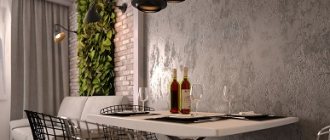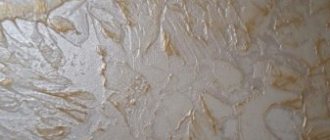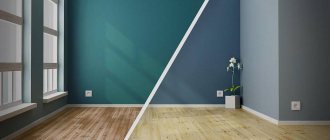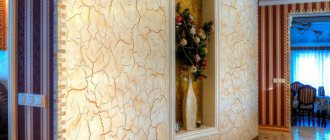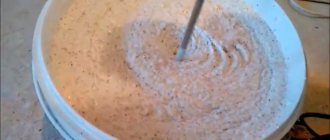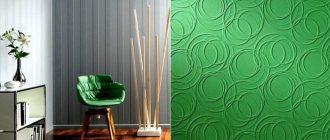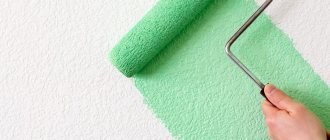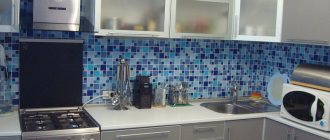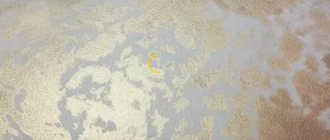If you want to decorate the walls in an unusual way, it is advisable to use original paint and varnish materials. Decorative wall paint is optimal for interior decoration. It has the unique ability to create an original wall covering with a spectacular texture.
It allows you not only to create a beautiful background picture of the interior in any color scheme. Without much effort or painting skills, any admirer of non-trivial decorative solutions will decorate a room with an imitation of silk, sand, wood, leather, stone or any other material. Decorative wall paint is indispensable in the process of painting and creating the effect of textured plaster. It embodies all kinds of ideas for decorating an apartment or house.
Decorative paint for walls: characteristics of features
This type of paint and varnish material is produced by adding artificially created components to the composition in the form of metallized, stone, fabric and other particles. Depending on the type of paint, the composition is diluted with a specialized solvent. This determines the density and decorative appearance of the wall covering.
Among the huge variety of finishing materials for painting, decorative wall paint has the following advantages:
- safe for others due to the creation of a coloring composition from organic components;
- easy to apply using a roller, spray gun or brush;
- dries quickly;
- economical in consumption;
- withstands moisture and direct sunlight;
- has a wide range with a variable color palette and decorative effect;
- unpretentious in care.
Decorative paint has a wide range with a variable color palette
The coating has high moisture resistance. After the walls have completely dried, you can regularly carry out wet cleaning. Unlike wallpaper, finishing with decorative paint does not attract dust and retains its original appearance for a long time.
If cracks or any other defects occur due to accidental mechanical impact or careless handling by pets, you can easily eliminate any defect on the wall. To do this, you need to buy finishing materials with a reserve. Different batches of paints and varnishes may have minor differences in color tone.
Decorative paint retains its appearance for a long time
Ideal walls: paints and plasters
Users of forumhouse.ru know well that repairs are a delicate matter.
And when it comes to decorating rooms, the choice of material for finishing walls and ceilings often becomes a stumbling block. And if previously wallpaper was traditionally chosen as a finishing coating, now there are many materials on the market suitable for creating the interior of your dreams.
For example, decorative paint and plaster.
But how not to get confused in their diversity and make the right choice? What do you need to know about the features of using these materials?
Our article is dedicated to answering these questions!
Features of decorative paint and plaster
Modern decorative paints and plasters are materials that allow you to realize the most unusual and daring design ideas. And if earlier plaster or paint was considered only as a basis for applying a finishing coating, today these materials themselves act as a stylish and sophisticated decor. And in order to choose exactly what you need, you should know some of the features of these materials.
Head of Marketing Department of ROGNEDA Group of Companies Ekaterina Odzilyaeva :
– First of all, you should remember that these materials must be applied to mineral surfaces (concrete, brick, plaster, etc.).
For rooms with high humidity, for example, bathrooms, such decorative coatings are usually not used. For this, there are tiles or special water-dispersion paints.
Conventionally, decorative materials can be divided into 3 groups:
- decorative paints;
- decorative plasters;
- decorative coverings.
Ekaterina Odzilyaeva:
– Decorative plasters, in turn, can be divided into smooth (thin-layer) and embossed (forming textured coatings).
In addition, all decorative materials can be classified as interior (used only indoors) and facade (can be used both indoors and outdoors).
But there are also secrets here.
Development Director Dmitry Redkin:
– In domestic practice, in addition to interior and facade materials, products for exterior use are often distinguished.
Materials for external work differ from facade materials in that they are only suitable for work in protected areas (for example, balcony niches) or on non-critical facades.
Dmitry Redkin:
– For decorative paints and varnishes, the key property is the type and size of the filler, since it is thanks to these components that a particular coating is formed. Various synthetic and natural materials and their combinations are used as fillers.
Despite the fact that there are a large number of varieties of decorative paints and plasters, we can say that the most popular are materials that imitate any surface.
TERRACO company expert , Alexey Kurbatov :
– Decorative paints and plasters can imitate stone, fabric, natural effects, metal, wood, etc. Paint allows you to create laconic interiors, and with the help of decorative plaster you can get interiors in Tuscan, Venetian or any other style.
Expert Sennekke Maria:
– For example, using decorative putty, you can create an interior with mirror-smooth surfaces or walls with a metallic effect.
Marbled style, spotted stains - all this can be achieved, depending on the chosen tool and the nature of the work.
In this case, the gloss can be increased until a mirror reflection is achieved.
This effect visually expands the boundaries of the room and gives them a memorable appearance.
You might think that choosing decorative paint or plaster requires some special knowledge or is a complex process.
But is this really so?
Ekaterina Odzilyaeva:
– As practice shows, to select a material you need to answer only 2 questions:
1. In what price range do you want to purchase the material?
As a rule, when choosing, they focus on the cost of 1 sq. m. m. covering.
2. What kind of coating do you want to get in the end: stone-like, fabric-like, simply embossed, or something else? Then you select it.
Decorative plaster is a high-quality finishing material, environmentally friendly, strong and durable.
Decorative plaster allows you to get perfectly smooth walls, because... During its application, the surface is leveled.
The simplest and most economical option is to purchase simple colored plaster, which consists of a sand-lime mixture, painted with a special dye, which gives the plaster a certain color.
But special decorative plasters that effectively imitate any surface provide greater freedom for creativity.
This finishing material is obtained by adding stone chips to the initial mixture. As a result, after finishing with such plaster, the interior of the room is noticeably transformed, because it effectively combines marble or granite surfaces.
In order for the applied plaster to serve you as long as possible, it must be applied to a durable surface, such as concrete or brick. Decorative plaster retains its original appearance for several years, which means that the room will not need cosmetic repairs for a long time.
In addition, decorative paint and plaster provide additional protection of premises from mold and mildew. And walls covered with these materials are resistant to moisture, do not fade under the influence of sunlight and are easy to clean.
It is believed that wallpaper gives the interior a memorable appearance. So why paint the walls then?
It should be noted that paints have been used by humanity since time immemorial; just remember the cave paintings. And, as practice shows, everything new is well forgotten old.
The following advantages of decorative paint can be highlighted:
- Long service life - at least 10 years.
In order to visually “refresh” the surface of the wall, you do not need to engage in a long and tedious process associated with tearing off old wallpaper. After all, new paint can be applied over the old one.
- Walls painted with decorative paint have no visible joints.
Thanks to the large selection of colors and application methods, you can experiment with color and texture and get a one-of-a-kind surface that best suits the interior of your room.
- Walls painted with decorative paint are easy to clean and dust does not collect on them.
The paint can be applied to almost any flat surface, be it drywall, glass, metal or cement base. But it should be remembered that the surface to be painted requires careful preparation and leveling of the base.
Tinting
When choosing a particular decorative coating color, it is important to understand how it will ultimately look on the wall. But what if you haven’t found the shade you need? In this case, tinting will help you.
Tinting is a process in which several colors are mixed to obtain the desired shade.
Dmitry Redkin:
– There are three methods for tinting paintwork materials:
- Industrial tinting: Paintwork materials are tinted in production and go on sale in various color options.
The downside is the small number of ready-made flowers.
- “Home” tinting: paintwork materials are tinted using pigment pastes or tinting paints by the buyer himself.
The main disadvantage of tinting using pigment pastes and paints is the impossibility of re-accurately matching the color.
- “Computer” tinting is the most modern and progressive type of tinting, the main property of which is the ability to obtain a large number of colors, accurately match the color from time to time and match the color of the paint with the color on the color selection tool (stand or fan).
The tinting process involves very precise dosing of pigment pastes into the base paint and is carried out using specialized equipment.
Ekaterina Odzilyaeva:
– Designers, painters and craftsmen, as a rule, tint plasters manually using tinting paints or universal tinting pastes. In this case, everything happens “by eye”.
It is more convenient for end consumers to tint the material in the store using machine tinting. As a rule, manufacturers of decorative coatings develop a tinting card, according to which you can select a suitable color and then tint the composition in this color in a machine.
Ekaterina Odzilyaeva:
– It often happens that the plaster itself does not need to be tinted at all, because the application technique involves further covering it with some kind of composition: wax, varnish or paint. In this case, the finishing composition is tinted.
Alexey Kurbatov:
– As a rule, each manufacturer has its own color fan or catalog of coatings.
My own master
As mentioned above, before you start applying decorative paint or plaster, you need to prepare the surface. After all, the final result depends on how carefully this stage of work is carried out.
Dmitry Redkin:
– Priming refers to the stage of preliminary surface preparation and, in fact, is the foundation for subsequent painting operations.
For priming, special paint and varnish primers are used. They serve to improve the adhesion of finishing coatings, reduce the consumption of subsequent paint layers, and increase the wear resistance and water resistance of the substrate.
The principle of operation of the primer is to completely or partially fill the pores of the substrate and create a thin film on the substrate that has protective properties.
Ekaterina Odzilyaeva:
– Priming is necessary for:
- better adhesion (adhesion) of the decorative material to the surface on which it is applied;
- increasing the service life of the coating;
- obtaining better coverage;
- strengthening the base on which decorative plaster is applied.
The primer is selected for each specific material. For some work, the most common water-dispersed acrylic primers are suitable, which are used before applying paint. For others (usually for textured, heavy materials) quartz primers are needed. As a rule, the manufacturer of decorative plaster always indicates in the recommendations for its use what kind of primer should be used.
Alexey Kurbatov:
– Many manufacturers have special adhesive and covering primers for specific decorative materials. But before applying such primers, a deep penetration primer must be applied.
This is done to strengthen the surface and reduce the consumption of specialized primer. The primer is applied using a roller, brush or spray. Surface preparation depends on the finish. For thin-layer coatings or paint, the preparation must be perfect, “like glass.” For some textured plasters, careful preparation is not required, because... the texture hides unevenness.
Many craftsmen have developed their own techniques for applying paint or plaster. However, there are also basic principles, based on which even an unprepared person can become the creator of his own interior.
Sennekke Maria:
– Application of decorative putty can be divided into several successive stages, for example:
1. Preparing the base.
The base must be level, clean, dry, without separating substances. Damaged surfaces of the base must first be leveled or, if necessary, sanded.
2. Surface priming.
3. Applying a decorative layer of plaster.
For economical and efficient processing, it is recommended to apply the product with a stainless steel spatula. The spatula can be pre-sanded with wet sanding paper
By varying the working and grinding technique, you can achieve a variety of optical effects. For example, to create a Venetian-style surface, you need to use a Venetian trowel and a short-haired roller. This will give the coating structure and obtain a characteristic velvety effect.
Ekaterina Odzilyaeva:
– Using different working techniques and tools, you can get an infinite number of textures from one plaster. Everything depends only on you: take a spatula - you get one coating, a roller - another, a brush - a third, etc.
Alexey Kurbatov:
– There are many ways to apply decorative paints and plasters. Brushes, trowels, rollers, tampons - this is just a small list of tools used for applying decorative paint.
Dmitry Redkin:
– The following methods of applying liquid coatings can be distinguished, which are used depending on the area of the surface being treated.
- manual methods based on surface wetting (adsorption);
- mechanized methods based on the conversion of paints and varnishes into aerosols, followed by spraying and film formation.
Manual methods are traditional and understandable painting with rollers, brushes and other hand tools. To carry them out, direct contact between the solid surface and the liquid paint and varnish material is necessary.
The brush should have thick, long bristles, cone-shaped at the tip, easily restoring its shape after bending. Bristles can be natural or synthetic. For water-based coatings, it is better to use a brush with synthetic bristles, because, unlike natural bristles, it does not absorb water, does not swell and retains its shape.
The roller is used for painting large areas. The smoother the surface to be painted or the more shiny the paint, the shorter the pile (coat) on the roller should be.
Mechanized methods involve the use of special equipment - sprayers, which, depending on the operating pressure, are divided into air and airless.
Sometimes during the painting process a thought comes to mind: is it possible to somehow speed up the drying process, and most importantly, won’t this lead to a decrease in the performance qualities of the applied material?
Ekaterina Odzilyaeva:
– The material must dry exactly as long as it must dry under certain conditions: temperature, air humidity.
Alexey Kurbatov:
– After applying a coat of paint or plaster, allow it to dry completely. Depending on the material, this can last from 2 hours to 3 days.
It is strictly forbidden to speed up the drying process, because... this impairs the adhesive properties of materials!
Also, wood painted in a certain way often acts as a decorative element.
TBM company expert Anatoly Koverdyaev:
– In modern construction, the use of wood as a material for decoration is becoming increasingly common.
Using lining, imitation timber, block house or planken, you can give a beautiful appearance to buildings and premises made of brick and concrete.
But cladding wood is a living material, and therefore needs the same protection from external factors as a house made of logs or timber.
The peculiarities of painting lining and block houses are that it is more expedient to paint them before attaching them to the wall. In this case, it will be possible to obtain the highest quality paint coating. Anatoly Koverdyaev:
– The main parameters when choosing materials for painting linings and block houses are the drying speed and the absence of “sticking” of the painted products. And if we follow all the stages of sanding, painting and varnishing the cladding material, then in the end we get a hand-made product that is ideal for interior finishing.
Users of forumhouse.ru can find out all the information about how to approach the design of premises in this section of our forum. A detailed and visual story from our forum member about creating panels from gypsum non-shrinking plaster can be found here. Wall paintings in a modern interior are discussed in this thread of our forum. Should I paint the walls or wallpaper? Our forum members are discussing this issue here. This section presents live examples of painted wooden facades. How to make life bright? Find out in this video for the latest design and decorating ideas. And from this video you will learn the secrets of decorative wall painting.
Classification of wall paints with a decorative effect
Depending on the composition, paint and varnish materials are divided into different types:
- alkyd;
- adhesive;
- water-based;
- flock;
- mosaic;
- textured.
Applying textured decorative paint for walls
Each of them has unique properties that should be taken into account when choosing a finishing material for interior wall coverings.
How to paint walls correctly: preparation and consumption per 1m2
Decoration with paint is possible on concrete, wood, plastic, plasterboard and chipboard. Before applying the coating, you must carefully putty all the unevenness and defects of the wall, and then prime it.
Depending on the type of paint and the desired texture for application, you may need:
- Brushes of different sizes.
- Rollers and spatulas.
- Spray guns.
Remember that some types of paint must be applied in stages or using special tools. For example, paint with a metallic effect is applied in several layers, and “stone” paint with the effect of granite or marble is applied using a spray gun.
To calculate paint consumption during repairs, you need to know two indicators:
- Surface area to be painted.
- Paint consumption per 1 m2 . This indicator is indicated on the paint can. Most manufacturers indicate consumption in grams per m2. If you don’t have a can at hand, then as a guide you can take the consumption for latex paint 125 ml per 1m2 .
To calculate the area of the surfaces to be painted, you need to calculate the perimeter of the wall (wall length + wall width)*2) , and then multiply the value by the height of the wall. From the obtained value we subtract the area of windows and doors (calculated using a similar formula) and obtain the total area of the surface to be painted.
How to properly apply on walls video lesson
Features of alkyd paint
Alkyd finishing materials are divided into two types: oil-based with a drying oil base and enamel with a high varnish content. The appearance of the wall depends on the base.
Decorative paint with drying oil composition is made from artificial and natural oil bases - linseed and sunflower. When used, you get a beautiful coating with a shiny surface. It belongs to the budget segment of paints and varnishes. Oil mixtures have several disadvantages: they dry slowly, emit an unpleasant odor, and do not allow air to pass through well. Because of this, microcracks quickly appear on the coating.
Decorative paint with drying oil composition forms a glossy coating
Enamel compositions with a varnish base form a film that shimmers in the light. They withstand moisture and sudden fluctuations in room temperature. It is rational to use them when decorating bathrooms and kitchens, where there is high humidity and changes in air temperature. It is produced in a variety of colors. If it is necessary to use a certain tone, the enamel mixture can be diluted with a solvent, obtaining any color gradation. After opening the package, it can retain its performance properties for a year.
It is rational to use enamel paints for bathroom decoration
Calculation of material consumption
To calculate the required amount of material per 1 m2, you need to use a special formula. To do this, measure the total area of the plastered facade during exterior finishing. When working internally, it is necessary to measure the length and height of each surface being processed. After which the values are multiplied, and the final result is obtained. The main thing is not to forget to exclude the area of doors and windows from the calculations. Next, the average paint consumption is multiplied by the total area. Average consumption information can be found on the product label.
Pros and cons of adhesive mixtures
Adhesive paints and varnishes are created by combining chalk, hot water, glue and color. They contain a large amount of water, which provides excellent air exchange.
It is not recommended to use adhesive mixtures for finishing rooms with high humidity. The influence of moisture promotes the formation of mold and mildew.
Adhesive decorative paint produces a matte surface
As a result of its use, a matte surface is formed on the walls. It is excellent for finishing concrete, brick and plaster walls. With frequent wet cleaning, the coating quickly loses color and the matte base is washed off.
Wet silk paint with pearlescent effect
The pearlescent shade will add luxury and sophistication to the interior. Unobtrusive mother-of-pearl will emphasize the visual depth of color, as well as its multidimensionality. In this case, the technique of applying the material and operating the coating will be as simple as in the case of the previous version. Pearlescent decorative paint from Decorazza - Seta da Vinci, which is economically used (only 200 grams per 1 square meter!), provides improved coverage and allows for wet cleaning. This is guaranteed by a high-quality binder and special additives included in the material.
Distinctive features of water-based paint
The production process uses water and polymer pigments. During the drying process, the water completely evaporates and a perfectly smooth base is formed. During use, it can be washed and wiped with a damp cloth or rag. It is strictly forbidden to use cleaning devices with an abrasive base or chemical detergents to care for painted walls. They violate the integrity and change the color of the coating.
The water-based composition has significant advantages:
- dries instantly;
- has a high degree of hypoallergenicity;
- does not emit a pungent odor;
- retains color when exposed to direct rays of light;
- easily acquires the required color and tone when adding pigments.
Water-based paint dries instantly and does not emit a strong odor
Water-based wall paint is divided into several types:
- acrylic, due to its resinous composition, forms a super-durable coating that perfectly withstands the negative influences of the environment;
- latex has a water-dispersion base, absolutely safe for the health of people and pets;
- silicate is made from a combination of liquid glass and coloring pigments, creating an ultra-durable and breathable coating.
Regardless of the composition, water-based mixtures quickly acquire the desired tone when adding the desired color, are easily applied to the wall and have a high degree of wear resistance. Each type creates a different coating: matte, shiny, changing color shade under the influence of artificial and natural light. The choice of finishing material should be based on individual requirements and design objectives.
Water-based paint acquires the desired color when color is added
The need to use a textured roller
To evenly cover the walls with any of the above types of paint, it is important to use a brush, roller or paint sprayer. To create a patterned, ornamental or relief surface, a textured or textured roller is indispensable. This painting tool has the design of a regular roller, but is equipped with an attachment with an ornamental base. When applied to a freshly painted wall, the textured roller leaves patterned imprints.
Textured roller for textured surfaces
Nozzles are made from different materials that create unique effects:
- leather is necessary when simulating the texture of granite, marble, sand or Venetian plaster;
- wooden with expressive patterns creates rectilinear reliefs in the likeness of finishing with canvases of identically designed wallpaper;
- rubber, depending on the shape, size of the recesses and bulges, imitates the effect of brick, tile or stone masonry;
- fabrics with variable textures realistically convey the relief of crocodile or snake skin.
Textured roller conveys the relief of crocodile skin
Textured rollers with designer attachments are necessary to give the walls a special look with a pronounced relief in the form of foliage, frosty patterns or raindrops on glass. The depth of the ornamental design and the expressiveness of the patterns directly depends on the degree of pressure on the roller when decorating the walls. Using regular rollers in tandem with stencils helps achieve an equally impressive coating with beautiful patterns.
Roller for applying floral designs
Characteristics of flock and mosaic paint and varnish mixtures
Flock paints have a unique composition of heavy-duty glue, a variety of flakes of different colors, shapes and sizes. They must be applied in stages:
- a perfectly flat surface is covered with a layer of adhesive;
- using a specialized sprayer, a wall with an adhesive base is decorated with variation flocks in clearly defined areas or with a chaotic distribution;
- After the adhesive base has dried, acrylic varnish is applied, which secures the flocks and gives a characteristic shine to the surface.
A wide range of flock mixtures allows you to create a non-trivial-looking finish that creates a festive atmosphere in the interior. They are great for hiding any imperfections on the walls: scratches or cracks can easily be hidden under a layer of decorative flakes.
Flock paints perfectly mask wall defects
Mosaic mixtures contain multi-colored granules of various shapes and structures. They form a bulk layer. Thanks to this feature, they can be used to mask any depressions and bulges on the walls. Ideal for creating original finishes. They perfectly accurately copy the texture of shiny sequins, fleecy fabric and the texture of mosaic wall cladding with ceramic tiles of regular or asymmetrical shape.
Advantages of finishing walls with textured paint
Textured finishing materials open up limitless design possibilities when decorating walls. In accordance with fashion trends in interior decor, using textured paint, you can create a surface on any surface that imitates natural materials: stone chips, metal, wood, travertine, onyx, minerals, seashells and other organic bases.
The effect of natural texture is formed by adding characteristic components and artificially:
- to imitate marble and granite stone, the acrylic composition is saturated with oxygen, which promotes the formation of a porous surface;
Decorative paint imitating the surface of stone
- to copy the texture of velvet and silk, the paint base is filled with solid particles with a fabric structure;
Decorative paint for walls with velvet texture
- To create the effect of a metallized surface, the textured mixture is diluted with iron chips of gold, silver, copper and other colors.
Golden surface effect
This type of finishing materials, forming a relief coating, is capable of creating a dynamic background to the interior picture due to the variable color scheme. A pearl base is easy to make using pearlescent mixture. To obtain a patinated “antique” surface, it is important to use an option with a metallic sheen to finish the base with specially created small cracks. To paint walls in a modern design style, you need to use paint and varnish mixtures with luminescent properties. They attract and retain natural light until dark. In the twilight, the surface glows brightly and creates a mesmerizing spectacle.
Luminescent colors create a mesmerizing spectacle
Features of silk fabric
Thanks to such unique colors, you can create the visual sensation of exquisite Arabic fabrics on the walls of your room. This coating looks good when creating an interior in both a modern and conservative style. Silk is a delicate fabric that is extracted from the cocoon of the silkworm. Due to the fact that the fabric is quite soft, people have been using it for a long time to sew clothes for rich noble people.
The indescribable shine and shimmer of silk fabric is obtained due to the triangular cross-section, resulting in refraction and reflection of light rays. In the modern world, silk is used not only as a fabric in weaving, but also as interior decoration. In these areas it is used in the form of a product called liquid silk. Liquid silk is a homogeneous ready-made mass that is ivory in color with a unique pearlescent sheen. This product was first used by Italian craftsmen as a decorative coating. It goes well with interior materials such as velor.
Technology of using decorative paint for walls
In order for the new coating to look perfect after painting, it is necessary to carry out the preparatory work efficiently. The walls need to be carefully treated:
- It is ideal to clean the surface of wallpaper or old paint using a spatula or wire brush.
- Remove switches and sockets, covering the wires with thick cardboard or foam.
- Cover any uneven areas with gypsum plaster.
Eliminate unevenness with gypsum plaster
- Level using finishing putty.
- Sand the surface with sandpaper.
- Prime.
Coating walls with primer
Decorative wall paint with the effect of silk, sand, concrete or any other design must be applied to a dry surface. The coating must begin with curved and hard-to-reach places: corners, ceiling curbs, niches in the radiator area. To finish large surfaces, it is rational to use a roller. To paint protrusions or corners, use a brush with natural bristles.
Use a roller to finish large surfaces
The technology for using decorative paint depends on its base and the desired effect. In almost any embodiment, its use involves applying a double layer of the mixture to the surface: the first creates a background, the second creates a pattern or ornament. This finish looks unusual when combining contrasting tones. Drawings, ornaments or monograms of dark colors look dynamic on a white base. On a black or brown base, mother-of-pearl or blue surface with dark veins of masterly form shimmers presentably.
Wall decoration with contrasting colors
Decorative paint with silk effect - what is it?
Silk screen paints give the room a more elegant and presentable look. This is achieved by giving the walls the effect of woven fabrics stretched over them. In order to obtain a similar effect, the following types of components are used:
- Acrylic resin, which plays the role of a connecting component, preventing water from spreading;
- Water, its use is environmentally friendly, so the use of paint is not harmful to health, and is suitable for different rooms;
- Pearlescent dye is what gives the surface a silky glow.
Silk paint glows when exposed to sunlight, so the effect is brighter in places where it hits through glass.
Silk screen paints give the room a more elegant and presentable look.
Decor paint effects
Silk-screen printing paint allows you to obtain different effects; they depend on the components included in the composition and the method of applying them to the surface. If the walls were painted with one color, then various designs can be applied on top of them using a prepared stencil. Plastic stencils are better suited; paint can be applied to the wall through them with a brush or by spraying.
Stardust effect, a dye is sprayed onto a painted wall, and the effect can be created using a brush with long bristles, which is sprayed onto the walls. Options with a pearlescent glow look more impressive.
Options with a pearlescent glow look more impressive.
The coating can be a chaotic pattern; for this, fabric elements are wound on a roller, which are then immersed in silk wall paint, and the roller is rolled over the wall. The pattern is distributed chaotically.
Contrast effect, applying contrasting shades to the main color will look original. You can draw various patterns in contrasting colors.
The coating can be a chaotic pattern; for this, fabric elements are wound on a roller.
How is it different from the usual
The main difference from ordinary paint is the presence of a mother-of-pearl effect, which gives the surface a mysterious and attractive shine. In this case, paint can be applied in different ways. Thus, you can choose a suitable wall decoration option for yourself. Otherwise, it is similar to other paint and varnish products; it can also be applied with a roller or brush.
The main difference from ordinary paint is the presence of a mother-of-pearl effect, which gives the surface a mysterious and attractive shine.
Variations in the design of decorative wall decoration
To create an exclusive picture of the interior of your home, it is extremely important to take advantage of the unlimited capabilities of decorative paint. It can transform the usual appearance of walls beyond recognition:
- imitate coating with gold, silver, diamonds and other types of precious stones and metals;
- create the effect of draping with silk, velor, brocade and other types of luxury fabrics;
- change the color of the surface depending on the intensity and angle of incidence of light;
- visually increase the area of small rooms when using paint with a mirror effect;
- copy the appearance of a sandy beach, coral reef, sea surface, grass and foliage cover.
Decorative paint can transform the appearance of walls beyond recognition
Non-trivial wall decoration with decorative paints is an excellent alternative to the banal-looking wallpapering, tiling or Venetian plaster. It can reflect the aesthetics of different design styles:
- in a classic interior, finishing with paints and varnishes that create the effect of a fabric covering looks organic;
- in rooms designed in a loft or industrial design style, imitation brick or stonework looks balanced;
Imitation of a brick wall using decorative paint
- in houses where Provence or shabby chic dominates, it is important to use multi-colored finishes and decorate the walls with an abundance of floral motifs and ornate floral patterns;
Floral patterns for interiors in Provence style
- decorative wall paint with a sand effect is optimal for decorating rooms that involve the use of colonial, Moroccan or Mediterranean design concepts;
- in interiors reflecting the features of minimalism and high-tech, it is rational to use paint with metallized or glass components.
Decorative paint with metallized components
The style of any design direction can be easily conveyed by choosing variable decorative paint. In addition to the unsurpassed textured effect, they have impeccable performance properties: shape and color stability, regardless of the influence of moisture, light and minor mechanical stress.
Having learned the unique features of decorative paint and the basics of painting skills, you can not only create an exclusive picture of the interior in any room, but also forget about repairs for a long time . The spectacular appearance of the walls will delight others for a long time with their pristine condition and surprise guests with the creativity of the original painting.
Preparing the wall before applying paint step by step
In order for decorative paints with any effects to apply smoothly, painting to take little time, and the result to be a smooth surface, it is necessary to prepare and treat the walls.
Decorative paint
Decorative paints and plasters can be applied to any surface: concrete, plaster, cement, plastic and wood, brick and metal. You can paint a room with a ceiling in 1 day; the paint dries quickly (on average 24 hours), lasts a long time, and does not have an unpleasant odor.
Treating the walls in preparation for applying a decorative coating is necessary, but there is no need to level the surface to an ideal state or make a screed, as before gluing wallpaper.
Decorative paint
Before applying the finishing, decorative coating, you must:
- Clean the wall surface. First, remove the wallpaper, remove the old paint and plaster and cover the wall with new. It is important to check that there are no oil stains on the walls; if there are any, they must be removed with a solvent.
- After the solvent, you need to wash the walls with a light soap solution. If the wall was previously covered with whitewash or oil paint, it is sanded, but not cleaned.
- The next step is to treat the walls with an antifungal compound. This is true if there is high humidity in the room. Also, if there are cracks in the walls, they need to be repaired.
- After this, you need to prime the walls and let the primer dry.
- Apply putty to smooth out any unevenness on the wall. Putty also serves as the basis for decorative plaster. Sometimes you can do without it, but only if you plaster the wall with a thick layer.
- 24 hours after applying the putty, the walls can be coated with acrylic primer. It will improve the adhesion of layers.
- After the primer has dried, sanding is done using fine-grain sandpaper.
- If it is necessary to apply a coating without abrasive particles, the wall must be smooth, so all sagging and defects are sanded by hand, and then a finishing primer is applied. After it has dried, the surface can be painted.
Decorative paint
Remember that after professional work on leveling the wall or creating a screed, the surface can be painted with decorative paint only after 28 days, after it has completely dried and hardened.
The specifics of preparation will depend on the type of paint and the technology for its application. Having chosen paint for decorative plaster, you can plaster the walls only once.
Decorative paint gray
